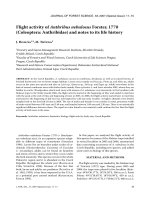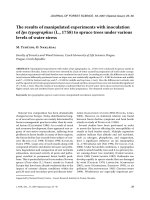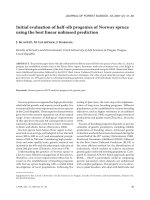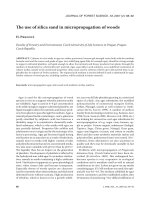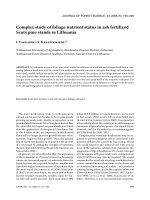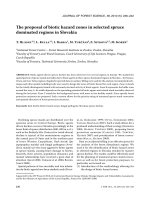Báo cáo lâm nghiệp: " Feeding ecology of pine shoot beetles (Tomicus spp.) in tree crowns of Scots pine (Pinus sylvestris L.) stands under one-year outbreak" pptx
Bạn đang xem bản rút gọn của tài liệu. Xem và tải ngay bản đầy đủ của tài liệu tại đây (188.14 KB, 7 trang )
J. FOR. SCI., 53, 2007 (10): 445–451 445
JOURNAL OF FOREST SCIENCE, 53, 2007 (10): 445–451
Pine shoot beetles, Tomicus piniperda (L.) and
T. minor (Hart) (Coleoptera: Scolytinae), are widely
distributed in the Palaearctic Region infesting vari-
ous pine species within their natural ranges (N-
1947; L et al. 1977). In the early
1990s T. piniperda was introduced into North
America. It was detected for the first time near
Cleveland, Ohio (H, K 1993). One of
the methods of evaluating the population size of
the pine shoot beetles is the estimation of numbers
of shoots damaged by adult feeding in pine crowns.
is is accomplished either by counting damaged
shoots in crowns of standing or felled sample trees
(L, H 1991; MC,
S 1995; H et al. 2001; L et
al. 2002; L et al. 2003) or by collecting on
sample plots the shoots pruned by adult beetles
and fallen onto the ground under infested trees
(M, W 1962; L 1978;
L 1983; L, H
1990; A, H 1991; B 2001,
2006a,b; L et al. 2001; C et al.
2003; M et al. 2006). e number of
damaged shoots is the basis for estimating losses
in tree increments (M, W 1962;
N 1974; L, H 1990, 1991;
C et al. 1997; B 2001, 2006a,b).
In forestry, it is also the basis for prediction of the
occurrence of pine shoot beetles. In Poland, besides
the number of dying trees, the number of collected
fallen shoots is used to estimate the degree of threat
to Scots pine stands (A 2004).
e ecology of feeding of pine shoot beetles in
crowns of healthy pine trees has been studied in
many scientific centres around the world (E,
N 1968; Š 1968; S 1973; B-
1974; L 1980, 1983; E et al.
1985; Y, Z 1995; Y 1996; P et al. 2002;
E et al. 2004). Results of studies have indicated
that some quantitative aspects of beetle feeding in
Feeding ecology of pine shoot beetles (Tomicus spp.)
in tree crowns of Scots pine (Pinus sylvestris L.) stands
under one-year outbreak
A. B
Institute of Biology, Świętokrzyski University, Kielce, Poland
ABSTRACT: Studies were carried out in southern Poland during 2002–2006 in Scots pine stands under the effect of
an outbreak of pine shoot beetles. e qualitative aspects of beetle feeding in tree crowns, studied on the basis of fallen
shoots collected on experimental plots, are presented in this paper. e beetle numbers affected the age distribution
of damaged shoots and the proportion of multiple attacks. e proportions of one-year-old shoots and the numbers
of shoots with more than two attacks increased in the marginal part of the stand in the year of intensive feeding of
beetles and in the subsequent year. A similar proportion of shoots with two attacks in both stands under investiga-
tions in individual study periods, with no relation to beetle numbers, does not permit to use this characteristic for
forecasting purposes. e average length of tunnels in shoots attacked once reached 20 mm at maximum. e average
length of tunnels (measured from the place of shoot disruption) was greater in shoots with two attacks than in shoots
with a single one (P < 0.0001). e difference was not significant (P = 0.3429) only in stand B during the study season
2004–2005. e majority of the tunnels made in apical portions of shoots with two attacks damaged the tissue of api-
cal shoots. e distance between the base of the second tunnel and the shoot apex in shoots with two attacks, and its
significant (P < 0.01) linear relationship with the length of beetle tunnels, indicated a high nutritional quality of apical
portions of shoots.
Keywords: Tomicus piniperda; T. minor; Pinus sylvestris; needle drop; shoot damage
446 J. FOR. SCI., 53, 2007 (10): 445–451
pine crowns may be useful for the estimation of den-
sity and population dynamics of pine shoot beetles
(L 1983; H et al. 2001). For example,
the number of multiple attacks as a result of beetle
competition for a limited number of shoots suitable
for colonization or the number of shoots damaged by
a single attack are important characteristics.
is paper presents ecological aspects of pine shoot
beetle feeding in crown shoots of Scots pine in stands
situated at different distances from sawmill timber
yards. A 4-year study period, comprising a year of
pine shoot beetle outbreak, permitted to compare
and verify the results obtained. is study has been
justified by a lack of elaborations of this type concern-
ing stands of older age classes which were growing
during their entire life within the influence of a source
of the reproduction of these insects.
MATERIALS AND METHODS
Study site
e study site was located in Zagnańsk in south-
eastern Poland (longitude 20°45´E; latitude 50
o
55´N;
altitude 350 m). Studies were carried out in 2002
to 2006 on experimental plots established in pure
Scots pine stands situated 50 m (Stand A) and 500 m
(Stand B) away from sawmill timber yards existing
without break since 1916. In summer 2002, there
were over 500 m
3
of unpeeled pine timber stored in
the yards. is caused a mass migration of young
adults into surrounding stands which resulted in
severe damage in tree crowns reflected by a high
amount of tunnelled shoots found on the ground in
marginal parts of stands (B 2003).
Characteristics of the investigated stands:
Stand A: 90-years-old Scots pine stand, growing on
a fresh coniferous forest site, of a moderate crown
closure, mean dbh of 17.4 cm and mean height of
9.9 m. e canopy of trees was severely damaged
by beetle feeding in shoots repeated every year.
e top section of the crown, 1–2 m in length, was
either dead or heavily deformed.
Stand B: 90-years-old Scots pine stand, growing on
a fresh coniferous forest site, of an open crown
closure, mean dbh of 22.8 cm and mean height
of 18.5 m.
Shoot survey
e amount of fallen shoots was estimated on
permanent experimental plots. Shoots were col-
lected from the ground once a month from August to
December, and once more in March of the next year
after snow disappearance (this time span represents
the study season).
In 2002–2003 and 2003–2004 study seasons, a
sample consisted of shoots collected on four strips,
25 m long and 1 m wide, running in four cardinal di-
rections from sample tree No. 1, centrally situated in
an experimental plot. In stand A in 2002 one sample
was collected. In stand B in 2002 as well as in both
stands in 2003, due to a low level of shoot fall, three
samples were collected in each stand. e additional
samples were collected around trees No. 2 and No. 3
situated S–E and N–W from sample tree No. 1.
In 2004–2005 and 2005–2006 study seasons, a sam-
ple consisted of shoots collected on a plot 0.2 ha in
size (40 × 50 m) laid out around sample tree No. 1.
In the case of shoots found on the border of a sam-
pling plot every second shoot was taken.
Field measurements
On shoot collecting plots the following measure-
ments were carried out during 2004–2006 study
seasons: (i) age of stand was calculated as an arith-
metic mean of ages of 31 sample trees selected at
random (every tenth tree according to the exist-
ing tree numbering) and cored at the base of their
trunks; (ii) height of all pine trees was measured
to the nearest 0.25 m; (iii) dbh of all pine trees was
measured outside bark in N–S and E–W directions
to the nearest 0.5 cm.
Laboratory procedures
In the laboratory, the density of the shoot fall, the
age of shoots with separation into current growth
and one-year-old shoots, and the percentage of mul-
tiple attacks were determined for stands A and B in
the respective years. A multiple attack is the situation
when there are more than one beetle entrance holes
in a shoot in a given year. For shoots collected during
2004–2006 the following elements were measured to
the nearest 1 mm:
(i) shoot diameter at the place of break;
(ii) length of the beetle tunnel from the place of
break to its end (first tunnel);
(iii) distance of the second entrance hole from the
shoot apex in shoots with two attacks;
(iv) length of the beetle tunnel from the second en-
trance hole to its end (second tunnel).
Data processing
Shoot diameter measurements were analyzed us-
ing the Levene’s test for homogeneity of variance.
J. FOR. SCI., 53, 2007 (10): 445–451 447
Before the statistical analysis the data were log-trans-
formed. en, shoot diameter data were processed
by the factor analysis of variance (ANOVA) assum-
ing the stand and study season as classification fac-
tors. e post-hoc comparison was carried out on
the basis of the Tukey’s multiple range test.
Using Student’s t-test for unpaired samples, the
differences between the mean lengths of the first
tunnel with one and two attacks were checked.
To determine the relationship between the dis-
tance of the entrance hole of the second tunnel
from the shoot apex and its length the analysis of
correlation was used. e coefficients of rectilinear
correlation (r
n
) were computed and zero hypotheses
H
0
, according to which they are equal to zero, were
checked (F 1963; S, R 1981).
e analyses were carried out using the package
Statistica 6.1 (STATSOFT Inc. 2004).
RESULTS
Feeding of beetles in pine shoots in 2002–2006
During the study period a total of 4,838 shoots
damaged by adult feeding fell on experimental plots.
e mean shoot fall in individual years indicated a
high intensity of beetle feeding in pine crowns in
2002 in the marginal part of the stand (Table 1). Dur-
ing the remaining study seasons the shoot density
dropped below 1 shoot per 1 m
2
of ground. In stand
B, the mean shoot fall was below 0.5 shoots per m
2
,
which is characteristic of stands situated outside the
range of the reproduction centres of these insects.
e shoots damaged in the current growth part
dominated among damaged shoots found on experi-
mental plots (Table 1). e remaining fallen shoots
were the one-year-old shoots. No evidence of feed-
ing was found on two-years-old shoots and older.
e highest percentage of one-year-old shoots was
found in stand A during the year of intensive beetle
feeding (31.6%), and also during the next year (22%).
In subsequent years the percentage of one-year-old
shoots was below 10%. In stand B, the percentage
of one-year-old shoots during all study periods was
below 20%.
Among the collected shoots, the shoots with single
attacks dominated, while among shoots with multi-
ple attacks the shoots with two attacks prevailed (Ta-
ble 1). Shoots with more than two attacks (maximum
6) were found in stand A. eir proportion was the
highest in a year of intensive beetle feeding in pine
shoots (15.9%). In individual years the percentage of
shoots with two attacks was similar in both investi-
gated stands ranging from 11.2 to 21.6%.
Qualitative aspects of beetle feeding
in pine shoots in 2004–2006
The analysis of variance showed the influence
of the study season (F = 27.08, d.f. = 1,1,1947,
P < 0.0001) and did not confirm differences between
the two stands (F = 3.10, d.f. = 1,1,1947, P = 0.0784)
in respect of shoot diameter. e mean diameter of
fallen shoots in stand A during both study seasons
was similar, about 3.2 mm (range 2–9 mm). In stand
B during the study season 2004–2005 the mean di-
ameter of shoots was 3.6 mm (range 1–6 mm), and
it was greater than during the season 2005–2006
(3.1 mm, range 2–7 mm).
e mean length of beetle tunnels in shoots was
below 20 mm (range 1–108 mm) (Table 2). In stands
under investigations (with the exception of stand B
during the season 2004–2005) the mean length of the
first tunnel in a shoot with two attacks was greater
than in the case of shoots with single attacks (t-test;
P < 0.05) (Table 2).
e mean distance between the base of the second
tunnel and the shoot apex was 20 mm (range 4–86 mm)
Table 1. Characteristics of fallen shoots collected in stands under investigations
Stand and study
season
No. of shoots
fallen per m
2
Current shoots
(%)
Per cent frequency of the number of entrance
holes per attacked shoot
n
1 2 3 4 5 6
A
2002–2003 26.4 68.4 65.3 18.8 7.6 5.2 2.3 0.8 2,640
2003–2004 0.73 78.0 71.1 18.9 6.8 2.3 0.9 219
2004–2005 0.38 92.7 77.7 21.6 0.4 0.3 768
2005–2006 0.37 96.5 86.7 13.3 742
B
2002–2003 0.35 82.3 79.2 20.8 105
2003–2004 0.23 86.1 81.2 19.8 69
2004–2005 0.11 81.8 80.0 20.0 210
2005–2006 0.12 94.8 88.8 11.2 231
448 J. FOR. SCI., 53, 2007 (10): 445–451
(Table 3). e mean length of the tunnels was about
10 mm (range 3–57 mm). e results of correlation
analysis indicated that there were statistically signifi-
cant linear relationships between the distance of the
base of the second tunnel from the shoot apex and
the length of this tunnel. e coefficients of linear
correlation were statistically significant (P < 0.01)
ranging from 0.4224 to 0.8009 (Table 3).
DISCUSSION
Characteristics of fallen shoots, pruned by pine
shoot beetles, during the study period including a
year of their outbreak, permitted to explain many
important aspects of beetle feeding in shoots of Scots
pine crowns.
Feeding of beetles in pine shoots in 2002–2006
Scots pine unpeeled timber stored in the amount
of 500 m
3
became a source of the mass reproduction
of pine shoot beetles. eir adults migrated from
sawmill timber yards into surrounding pine stands
where they made feeding in tree crowns. eir high
numbers were manifested by the amount of falling
pruned shoots in the marginal part of the stand
(Table 1). e distribution of fallen shoots during
the study season 2002–2003 resembled rather a dis-
tribution during a strong 1-year attack or attack of
several years in duration (M, W
1962; S et al. 1987; L, H
1991) than the distribution during a long-term
outbreak characterized by a significant number of
fallen shoots at the distance of 1,000 m from sawmill
timber yards (L, H 1990). Shoot
fall in the marginal part of the stand during the
study season 2002–2003, accounting for 26.4 shoots
per m
2
, was much lower than the estimates of
L and H (1990, 1991), i.e. 60 to
100 shoots/m
2
.
e age distribution of fallen shoots in the in-
vestigated stands indicated a higher proportion of
one-year-old shoots in the marginal part of the stand
during a year of intensive beetle feeding (Table 1).
is probably resulted from a limited amount of
current growth shoots suitable for beetle feeding
in relation to a large number of beetles of young
generation migrating from sawmill timber yards.
A low proportion of current growth shoots a year
after an outbreak resulted from severe shoot dam-
age a year earlier. is is in agreement with results
obtained by L (1980) in Sweden, where
the proportion of current growth shoots was even
smaller (about 40%) and beetles were feeding on
2-years-old shoots and older. e age distribution of
fallen shoots during the growing seasons 2004–2006
Table 2. Length of the first tunnel in shoots with one (1) and two (2) attacks
Stand and study
season
Number of entrance
holes
Mean ± SEM (mm) n P
(t)
A
2004–2005
1 12.96 ± 0.51 603
< 0.0001
2 19.14 ± 1.14 165
2005–2006
1 11.59 ± 0.44 643
< 0.0001
2 18.49 ± 1.42 99
B
2004–2005
1 13.71 ± 0.84 168
0.3429
2 15.59 ± 2.07 42
2005–2006
1 9.05 ± 0.49 205
< 0.0001
2 16.57 ± 2.31 26
Student’s t-test, P < 0.05 indicates statistically significant differences
Table 3. Relationship between the distance of the entrance hole of the second tunnel from the shoot apex and its length
Stand and study
season
Mean ± SEM (range) Coefficients of correlation
distance between
entrance hole and shoot
apex
tunnel length r
n
P for r
n
A
2004–2005 17.98 ± 0.54 (7–86) 10.55 ± 0.41 (3–57) 0.8009 < 0.0001
2005–2006 17.29 ± 0.92 (4–76) 9.61 ± 0.71 (2–63) 0.6662 < 0.0001
B
2004–2005 17.45 ± 1.32 (8–60) 9.35 ± 0.59 (3–18) 0.4224 0.0053
2005–2006 17.07 ± 0.76 (9–27) 8.92 ± 1.11 (3–23) 0.6888 0.0001
J. FOR. SCI., 53, 2007 (10): 445–451 449
in stand A, and during the entire study period in
stand B, characterized by a low and similar level of
shoot fall, probably reflected fluctuations in beetle
numbers at the age structure of the local population
of pine shoot beetles, i.e. mutual relations between
adults of old and young generation. Probably the
majority of maturation feedings are conducted in
current growth shoots, and in the case of their short-
age, feeding takes place in older shoots, although the
study results did not confirm this directly. is was
also pointed out by results of other studies (Š
1968; S 1973; L 1980).
e distribution of multiple attacks in stands un-
der discussion indicated that shoots with more than
two attacks, resulting from competition for a limited
number of shoots suitable for colonization, could
be of help in forecasting the population size of pine
shoot beetles. eir higher proportion a year after
an outbreak could have been caused by a limited
number of shoots suitable for colonization, which
was also indicated by a higher proportion of one-
year-old shoots during this study season. is was
also indicated by results of other studies. In Sweden,
in uneven-aged stands, shoots with more than two
attacks accounted for about 6% (L 1980),
in the United States in Christmas tree plantations
for about 12% (H et al. 2001), and for a few per
cent in China on Pinus yunnanensis Fr. (Y 1996).
e predominance of shoots with two attacks among
shoots with multiple attacks in stands of the present
study, irrespective of the distance from a source of
the reproduction of pine shoot beetles, during years
of low beetle feeding, makes their use in forecasting
impossible.
Quantitative aspects of beetle feeding
in pine shoots in 2004–2006
e mean length of the tunnel in shoots with a
single attack and the first tunnel in shoots with two
attacks was not over 20 mm. It was highly variable
in the range of 1 to 108 mm (Table 2). is is in
agreement with results of other authors. In studies of
Š (1968) the mean tunnel length was 16–23 mm,
in those of L (1983) it was 20 mm, and
H et al. (2001) 23 mm. e weak activity of pine
shoot beetles during the study seasons 2004–2006
does not permit to explain the fact of making longer
tunnels in shoots attacked earlier (with the excep-
tion of stand B during the study season 2004–2005)
(Table 2). A similar proportion of shoots with two
attacks in both stands indicated that making longer
tunnels is connected rather with the nutritional qual-
ity of shoots than with their shortage. As it has been
indicated by studies carried out in crowns of felled
trees, beetles prefer the apical parts of shoots. In
Scandinavia, the majority of single attacks took place
at the distance of 10 mm from the base of the apical
bud (L 1983). In the United States this
distance was 4–6 cm (MC, S 1995;
H et al. 2001) and in China 3–4 cm (Y 1996).
e results of this study also indicated a high nutri-
tional quality of apical portions of shoots. H
et al. (2001) observed that in shoots with multiple
attacks the subsequent attacks were made below the
earlier ones. is study showed that the first attacks
in shoots with two attacks took place at a distance
of about 20 mm from the shoot apex (Table 3). e
analysis of correlation showed a significant relation-
ship between the distance of the entrance hole of the
second tunnel from the shoot apex and the length of
this tunnel (Table 3). Beetles when making tunnels
attempted to reach the apical buds. e majority of
the tunnels more or less damaged the tissue of the
apical bud.
R efe re nce s
ANNILA E., HEIKKILÄ R., 1991. Breeding efficiency in Tomi-
cus piniperda and shoot damage after late autumn thinning
of young Pinus sylvestris stands. Scandinavian Journal of
Forest Research, 6: 197–207.
ANONYMOUS, 2004. Forest Protection Instructions.
Warszawa, CILP.
BEAVER R.A., 1974. Intraspecific competition among bark
beetle larvae (Col., Scolytidae). Journal of Animal Ecology,
43: 445–467.
BORKOWSKI A., 2001. reats to pine stands by the pine
shoot beetles Tomicus piniperda (L.) and T. minor (Hart.)
around a sawmill in southern Poland. Journal of Applied
Entomology, 125: 489–492.
BORKOWSKI A., 2003. Forecasting the occurrence of pine-
shoot beetles (Tomicus piniperda L. and T. minor Hart.) on
the basis of the needle drop. Sylwan, 147: 53–56.
BORKOWSKI A., 2006a. Spatial distribution of losses in
growth of trees caused by the feeding of pine shoot beetles
Tomicus piniperda and T. minor (Col., Scolytidae) in Scots
pine stands growing within range of the influence of a
timber yard in southern Poland. Journal of Forest Science,
52: 130–135.
BORKOWSKI A., 2006b. Shoot damage and radial increment
of trees in Scots pine (Pinus sylvestris) stands affected by a
one-year’s outbreak of pine shoot beetles Tomicus piniperda
and T. minor (Col., Scolytidae) in southern Poland. Electron-
ic Journal of Polish Agricultural Universities, 9: Issue 2.
CEDERVIND J., PETTERSSON M., LÅNGSTRÖM B., 2003.
Attack dynamics of the pine shoot beetle Tomicus piniperda
(Col.: Scolytidae) in Scots pine stands defoliated by Bupalus
450 J. FOR. SCI., 53, 2007 (10): 445–451
piniaria (Lep.: Geometridae). Agricultural and Forest En-
tomology, 5: 253–261.
CZOKAJLO D., WINK R.A., WARREN J.C., TEALE S.A., 1997.
Growth reduction of Scots pine, Pinus sylvestris, caused by
the larger pine shoot beetle, Tomicus piniperda (Coleoptera,
Scolytidae), in New York State. Canadian Journal of Forest
Research, 27: 1394–1397.
EAGER T.A., BERISFORD C.W., DALUSKY M.J., NIELSEN
D.G., BREWER J.W., HILTY S.J., HAACK R.A., 2004. Suit-
ability of some southern and western pines as hosts for the
pine shoot beetle, Tomicus piniperda (Coleoptera: Scolyti-
dae). Journal of Economical Entomology, 97: 460–467.
EIDMANN H.H., NOURTEVA M., 1968. Der Einfluss der
Siedlungsdichte und anderer Faktoren auf die Anzahl der
Nachkommen von Blastophagus piniperda L. (Col., Scolyti-
dae). Annales Entomologica Fennica, 28: 120–126.
ERICSSON A., HELLQVIST C., LÅNGSTRÖM B., LARSSON
S., TENOW O., 1985. Effects on growth of simulated and
induced shoot pruning by Tomicus piniperda as related to
carbohydrate and nitrogen dynamics in Scots pine (Pinus
sylvestris). Journal of Applied Ecology, 22: 105–124.
FISZ M., 1963. Probability eory and Mathematical Statistics.
New York, John Wiley & Sons.
HAACK R., KUCERA D., 1993. New introduction – common
pine shoot beetle, Tomicus piniperda L. U.S. Department
Agricultural Forest Service, Northeastern Area. Pest Alert
NATP-05-93.
HAACK R., LAWRENCE R., HEATON G., 2001. Tomicus
piniperda (Coleoptera: Scolytidae) shoot-feeding character-
istics and overwintering behaviour in Scots pine Christmas
Trees. Journal of Economical Entomology, 94: 422–429.
LÅNGSTRÖM B., 1980. Distribution of pine shoot beetle
attacks within the crown of Scots pine. Studia Forestalia
Suecia, 154: 1–26.
LÅNGSTRÖM B., 1983. Life cycles and shoot feeding of the
pine shoot beetles. Studia Forestalia Suecia, 163: 1–30.
LÅNGSTRÖM B., HELLQVIST C., 1990. Spatial distribution
of crown damage and growth losses caused by recurrent
attacks of pine shoot beetles in pine stands surrounding a
pulp mill in southern Sweden. Journal of Applied Entomo-
logy, 110: 261–269.
LÅNGSTRÖM B., HELLQVIST C., 1991. Shoot damage and
growth losses following three years of Tomicus-attacks in
Scots pine stand close to a timber storage site. Silva Fen-
nica, 25: 133–145.
LÅNGSTRÖM B., SOLHEIM H., HELLQVIST C., KROKENE
P., 2001. Host resistance in defoliated pine: effects of single
and mass inoculations using bark beetle-associated blue-stain
fungi. Agricultural and Forest Entomology, 3: 211–216.
LÅNGSTRÖM B., LISHA L., HONGPIN L., PENG C.,
HAORAN L., HELLQVIST C., LIEUTIER F., 2002. Shoot
feeding ecology of Tomicus piniperda and T. minor (Col.,
Scolytidae) in Southern China. Journal of Applied Entomol-
ogy, 126: 333–342.
LEKANDER B., BEJER-PETERSEN B., KANGAS E., BAKKE
A., 1977. e distribution of bark beetles in the Nordic
countries. Acta Entomologica Fennica, 32: 1–36.
LIEUTIER F., YE H., YART A., 2003. Shoot damage by Tomicus
sp. (Coleoptera: Scolytidae) and effect on Pinus yunnanensis
resistance to subsequent reproductive attacks in the stem.
Agricultural and Forest Entomology, 5: 227–233.
LOTTYNIEMI K., 1978. Effect of forest fertilization on pine
shoot beetles (Tomicus spp., Col., Scolytidae). Folia Fore-
stalia, 348: 1–19.
MARTIKAINEN P., KOUKI J., HEIKKALA O., HYVÄRINEN
E., LAPPALAINEN H., 2006. Effect of green tree retention
and prescribed burning on the crown damage caused by the
pine shoot beetles (Tomicus spp.) in pine-dominated timber
harvest areas. Journal of Applied Entomology, 130: 37–44.
McCULLOUGH D.G., SMITLEY D.R., 1995. Evaluation
of insecticides to reduce maturation feeding by Tomicus
piniperda (Coleoptera: Scolytidae) in Scotch pine. Journal
of Economical Entomology, 88: 693–699.
MICHALSKI J., WITKOWSKI Z., 1962. Untersuchungen
über den Einfluss des Regenerations- und Reifungsfrasses
von Blastophagus piniperda L. (Col., Scolytidae) auf den
Zuwachs eines jungen Kiefernbeständes. XI International
Congress of Entomology, Vienna 1960, 9: 258–261.
NILSSON S., 1974. Increment losses caused by Blastophagus
piniperda on Scots pine. Royal College of Forestry, Depart-
ment of Operational Efficiency, Research Notes, 78: 1–64.
NUNBERG M., 1947. Pine-shoot beetles. Prace IBL, 17: 1–20.
PETRICE R.T., HAACK R.A., POLAND T.M., 2002. Selection
of overwintering sites by Tomicus piniperda (Coleoptera:
Scolytidae) during fall shoot departure. Journal of Entomo-
logical Science, 37: 48–59.
SALONEN K., 1973. On the life cycle, especially on the
reproduction biology of Blastophagus piniperda L. (Col.,
Scolytidae). Acta Forestalia Fennica, 127: 1–72.
SAUVARD D., LIEUTIER F., LEVIEUX J., 1987. Répartition
spatiale et dispersion de Tomicus piniperda L. (Coleo-
ptera: Scolytidae) en forêt d’Orléans. Annales des Sciences
Forestières, 44: 417–434.
SOKAL R., ROHLF F.J., 1981. Biometry. New York, W.H.
Freeman and Co.
STATSOFT Inc., 2004. Statistica for windows (computer
program manual). StatSoft Inc. Tulsa, Okla.
ŠROT M., 1968. A contribution on the bionomics of M.
piniperda an the new methods of chemical control of injuri-
ous insects. Lesnícky časopis, 14: 375–390.
YE H., 1996. Studies on the biology of Tomicus piniperda (Col.,
Scolytidae) in the shoot-feeding period. Acta Entomologica
Sinica, 39: 58–62.
YE H., ZHAO Z.M., 1995. Life table of Tomicus piniperda L. its
analysis. Journal of Applied Entomology, 119: 145–148.
Received for publication June 18, 2007
Accepted after corrections July 16, 2007
J. FOR. SCI., 53, 2007 (10): 445–451 451
Ekologie žíru lýkohubů (Tomicus spp.) v korunách porostů borovice lesní
(Pinus sylvestris L.) v podmínkách jednoročního přemnožení
ABSTRAKT: Výzkum byl prováděn v jižním Polsku v období let 2002–2006 v porostech borovice lesní v podmínkách
přemnožení borových lýkohubů. V článku jsou prezentovány kvalitativní aspekty žíru brouků v korunách stromů,
které byly studovány na základě opadu výhonů sbíraných na pokusných plochách. Četnost brouků ovlivňovala věko-
vé složení poškozených výhonů a podíl jejich vícenásobných napadení. Podíl jednoletých výhonů a počet výhonů
s více než dvěma napadeními vzrostl v okrajové části porostu v roce intenzivního žíru brouků a v následujícím roce.
Podíl výhonů se dvěma napadeními byl podobný na obou studovaných místech v průběhu studovaného období
a nevykazoval žádný vztah k četnosti brouků, což nedovoluje využívat tento znak pro účely prognózy. Průměrná
délka požerků ve výhonech napadených jednou dosáhla maximálně 20 mm. Průměrná délka požerků (měřených
z místa ulomení výhonu) byla větší na výhonech se dvěma požerky než na výhonech s jedním požerkem (P < 0.0001).
Rozdíl nebyl signifikantní (P = 0,3429) jenom na ploše B v průběhu sezony 2004–2005. Většina požerků vyvrtaných
v koncové části výhonů se dvěma požerky poškodila pletiva apikálních výhonů. Vzdálenost mezi základnou druhého
požerku a apexem výhonu u výhonů se dvěma požerky a její signifikantní (P < 0.01) lineární vztah s délkou požerku
indikuje vysokou nutriční kvalitu apikálních částí výhonů.
Klíčová slova: Tomicus piniperda; T. minor; Pinus sylvestris; opad jehličí; poškození výhonů
Corresponding author:
Dr. A B, Świętokrzyski University, Institute of Biology, ul. Świętokrzyska 15, 25-406 Kielce, Poland
tel.: + 48 041 349 63 19, fax: + 48 041 344 88 05, e-mail:
